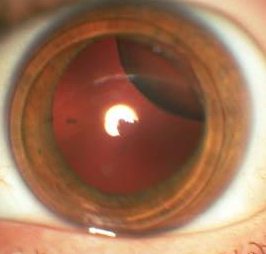Ectopia Lentis
|
|||
|
The pupil of the affected eye(s) is usually dilated for the examination. Describe the direction in which the lens is subluxated, this can help with the diagnosis. If the eye is not dilated, look for iridodonesis (abnormal tremor of the iris), phacodonesis (abnormal movement of the lens), deep anterior chamber depth or vitreous herniation into the anterior chamber. In the examination:
palate and arm span longer than height) but patient tends to be mentally subnormal and may have fair hair) or Weill-Marchesani's syndrome (mental retardation, short stature, stubby fingers) as Marfan's syndrome in the clinical examination) |
Questions:
1. What are the other causes of lens subluxation?Answer
2. What are the complications of a subluxated lens?
